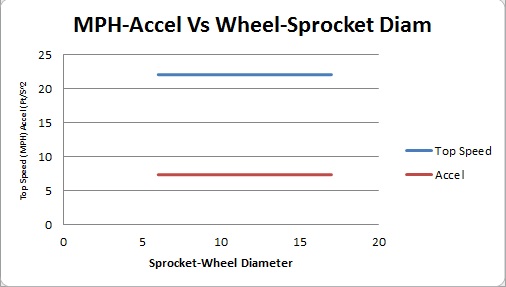Question: Does increasing the rear sprocket size to be the same size (or nearly the same size of the tire) cause the go kart to loose speed, especially as the tire gets bigger?
The question is a peculiar one especially for those that are making their own go kart and are wondering what ratio would work best on the go kart.
The question is this again, broken down into pieces:
The rear sprocket is the same size as the tire. If the tire gets bigger (and the rear sprocket correspondingly grows with the tire), what happens to the performance of the go kart?
Actually, nothing. The speed does not change, and the acceleration does not change.
I thought the answer I gave was preposterous myself, until I did the math. The following chart shows the corresponding Drive Wheel/Sprocket Sizes versus the overall top speed and acceleration (based on a 5 horsepower engine and a 300 pound gokart):

As the wheel diameter changes (the sprocket diameter changing proportionally with it) the top speed (MPH) and the acceleration (FT/S^2) does not change; they remain constant.
It is hard to grasp that as the sprocket and wheel grow together in size, that the overall performance would not suffer, but it does not.
So what does that mean for the go kart drive line enthusiast? The rule of thumb stands, keep your rear sprocket as large as possible (as close the wheel diameter as possible) and you will have a decent go kart performer.
As you notice, the ratios in the list all change starting from 6:1; 8:1, 9:1, 14:1 17:1. So the ratio does not tell the whole story, but is a start.
So how does this knowledge practically apply to a go kart?
If you for example are building a wood go kart, and the rule of thumb is being applied to have the rear sprocket (or pulley) as large us the rear tire, then what if you upgrade to a larger tire, from your small 7 inchers that you currently have? The rule of thumb still applies; you will have to make a larger pulley (or sprocket) to make the gokart perform like it did before.
Just in case you are thinking that you do not need to increase the sprocket diameter, because you increased the tire diameter, then you are going to run into stalling smoking clutches, and burning belts.
For more information about drive lines and computer program to help trouble shoot your drive line problems, go HERE. In this course you will learn how to calculate and make your own drive line system that will allow your go kart to climb hills without smoking the clutch.
Don’t be caught making a go kart and then have the drive line be the major headache. And you don’t have to spend a lot of money on drive systems, such as a fancy clutch, just to get what you want.
Again, the go kart drive line course has a computer program that helps maximize your drive line for optimum acceleration and hill climbing performance. Stop scratching your head, and get the answers explained and at your finger tips.



Hi there, Great to see you have progressed with the steering!
Thanks for your inquiry. Yes changing the wheel size will affect performance. We specialize in getting you to understand your drive line and then we equip you with some powerful tools to help you make your design decisions.
Our Go Kart Building 203 series goes into in depth and easy to understand detail so that you make informed purchasing and design decisions for your go kart design.
For example, we have charts and a program that helps you calculate your gokart drive line for optimum hill climbing performance. Along with go kart drive line design fundamentals and how to design your driveline.
Again thank you for your inquiry and just to let you know the best product value is the GoKartBuilding Bundle which includes the go kart drive line books and the program.